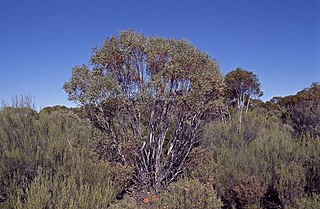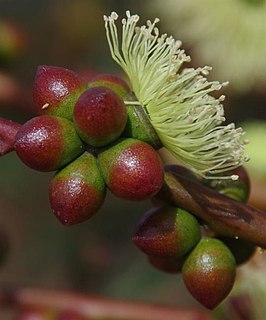
Eucalyptus leptopoda, commonly known as the Tammin mallee, is a species of mallee or rarely a tree, that is endemic to Western Australia. It has smooth mottled grey or brownish bark, sometimes with rough bark near the base, linear to curved adult leaves, flower buds usually in groups of seven and eleven, creamy white flowers and hemispherical to flattened spherical fruit.

Eucalyptus aspratilis, commonly known as the soak yate or inland mallee-yate, is a mallee that is endemic to Western Australia. It has rough bark near its base, smooth silvery greyish bark above, lance-shaped adult leaves, pendulous buds in groups of seven, pale yellow or cream-coloured flowers and cylindrical fruit.

Eucalyptus balladoniensis, commonly known as the Balladonia mallee, is a mallee that is endemic to an area in the south of Western Australia. It has rough bark on the lower half of its stems, smooth brownish bark above, lance-shaped leaves, flower buds in groups of seven, pale yellow flowers and hemispherical to more or less spherical fruit.
Eucalyptus blaxellii, commonly known as the Howatharra mallee, is a mallee that is endemic to Western Australia. It has smooth bark, linear to narrow lance-shaped adult leaves, flower buds arranged in groups of seven, white flowers and cup-shaped to conical fruit.

Eucalyptus effusa, commonly known as rough-barked gimlet, is a species of mallee or small tree that is endemic to Western Australia. It has thin, rough bark on the base of the trunk, smooth bark above, linear to narrow lance-shaped adult leaves, flower buds arranged in groups of seven, white flowers and cup-shaped to conical fruit.
Eucalyptus laevis is a species of mallee or tree that is endemic to Western Australia. It has thin, rough, fibrous or flaky bark on the trunk, smooth bark above. Its adult leaves are linear to narrow lance-shaped, the flower buds are arranged in groups of between seven and eleven, the flowers are white and the fruit is cylindrical to barrel-shaped.
Eucalyptus luculenta is a species of mallee that is endemic to a small area on the south coast of Western Australia. It has smooth bark, lance-shaped to egg-shaped leaves, flower buds in groups of seven, pale yellow to white flowers and cup-shaped, barrel-shaped or cylindrical fruit.
Eucalyptus protensa is a species of mallee that is endemic to the southwest of Western Australia. It has smooth, dark grey or brownish bark, narrow lance-shaped adult leaves, elongated flower buds in groups of seven, yellowish green flowers and hemispherical fruit.
Eucalyptus tenera, commonly known as the glazed mallee or sand mallee, is a species of mallee that is endemic to Western Australia. It has smooth bark, narrow lance-shaped to elliptical leaves, flower buds in groups of seven to eleven, lemon yellow flowers and cup-shaped to barrel-shaped fruit.
Eucalyptus tephroclada is a species of mallee that is endemic to the southwest of Western Australia. It has smooth bark, lance-shaped adult leaves, flower buds in pendent groups of nine to thirteen, pale lemon yellow flowers and barrel-shaped to cup-shaped fruit.
Eucalyptus vegrandis, commonly known as the Ongerup mallee, is a species of mallee that is endemic to the south-west of Western Australia. It has smooth bark, linear to lance-shaped adult leaves, flower buds in groups of seven, creamy white flowers and cup-shaped or conical fruit.

Corymbia ferriticola, commonly known as the Pilbara ghost gum, is a species of tree or a mallee that is endemic to Western Australia. It has smooth bark, lance-shaped adult leaves, flower buds in groups of seven, creamy white flowers and shortened spherical to cylindrical fruit.
Eucalyptus conveniens is a species of small mallee or shrub that is endemic to a small area on the west coast of Western Australia. It has smooth bark, sometimes with a short stocking of rough bark near its base, lance-shaped to egg-shaped or elliptic adult leaves, flowers buds in groups of three, whitish flowers and glaucous, barrel-shaped fruit.
Eucalyptus delicata is a species of tree that is endemic to Western Australia. It has rough, fibrous to scaly bark on the trunk, smooth white to greyish bark above, linear to narrow lance-shaped adult leaves, flower buds in groups of between seven and eleven, creamy white flowers and more or less spherical to barrel-shaped fruit.
Eucalyptus foliosa is a species of mallee that is endemic to Western Australia. It has a dense crown with foliage reaching to the ground, smooth greyish bark, linear to narrow lance-shaped or narrow oblong adult leaves, flower buds in groups of seven or nine, white flowers and conical to shortened hemispherical fruit. It is only known from a small area near Esperance.
Eucalyptus tephrodes is a species of small tree or mallee that is endemic to Western Australia. It has rough bark on the trunk and larger branches, smooth bark above, egg-shaped to lance-shaped adult leaves, flower buds in groups of three on the ends of branchlets and cup-shaped to hemispherical fruit.

Eucalyptus terebra, commonly known as Balladonia gimlet, is a species of gimlet that is endemic to Western Australia. It has satiny or glossy bark on its fluted trunk, linear to narrow lance-shaped adult leaves, flower buds in groups of seven, yellowish flowers and conical to hemispherical fruit. It is one of the seven species of gimlet.
Eucalyptus hypolaena is a species of tree or mallee that is endemic to Western Australia. It has hard, dark grey bark near the base of the trunk, smooth bark above, lance-shaped adult leaves, flower buds arranged in groups of seven, pale yellow flowers and shortened spherical to barrel-shaped fruit.

Eucalyptus semiglobosa is a species of mallee or small tree that is endemic to the south coast of Western Australia. It has smooth bark, broadly lance-shaped adult leaves, flower buds in groups of seven, creamy white flowers and ribbed or wrinkled, shortened spherical or hemispherical fruit.

Eucalyptus socialis subsp. eucentrica, commonly known as the inland red mallee, is a subspecies of mallee that is endemic to inland Australia. It usually has rough bark on the base of the trunk, smooth bark above, lance-shaped adult leaves, flower buds in groups of between seven and eleven, pale creamy yellow flowers and barrel-shaped to urn-shaped or spherical fruit.







